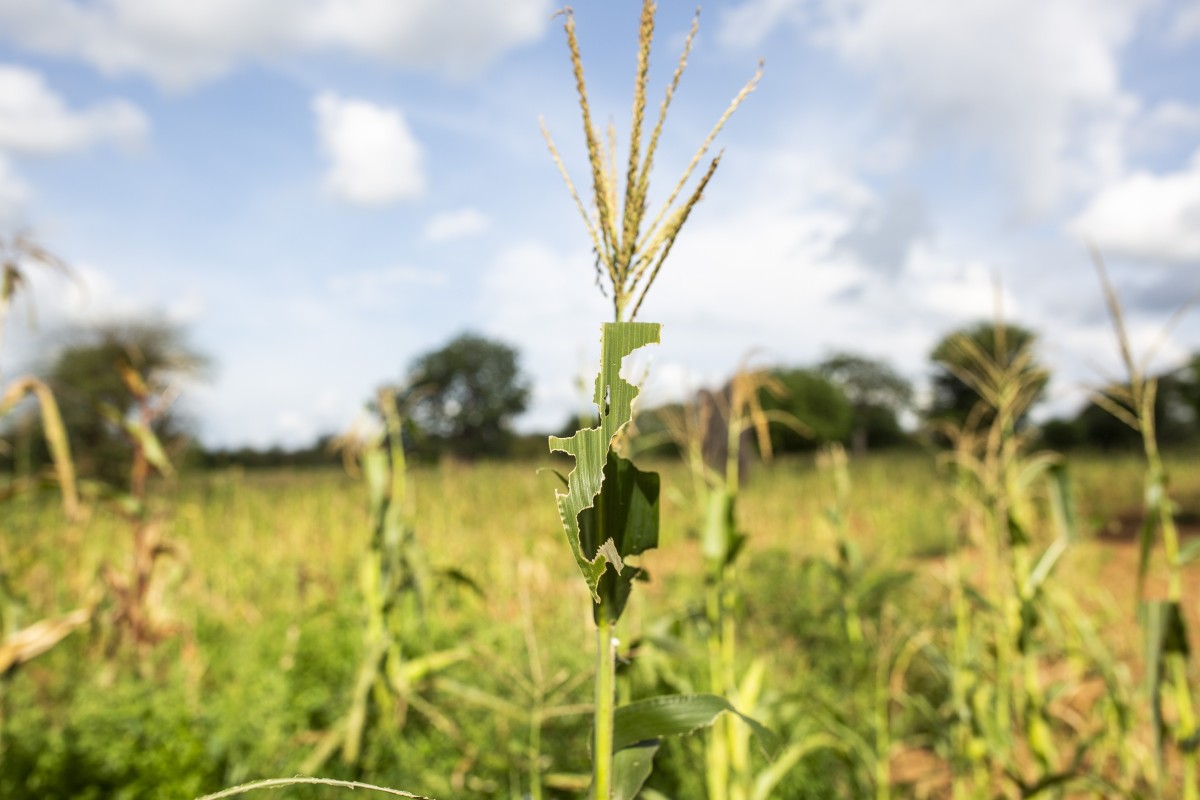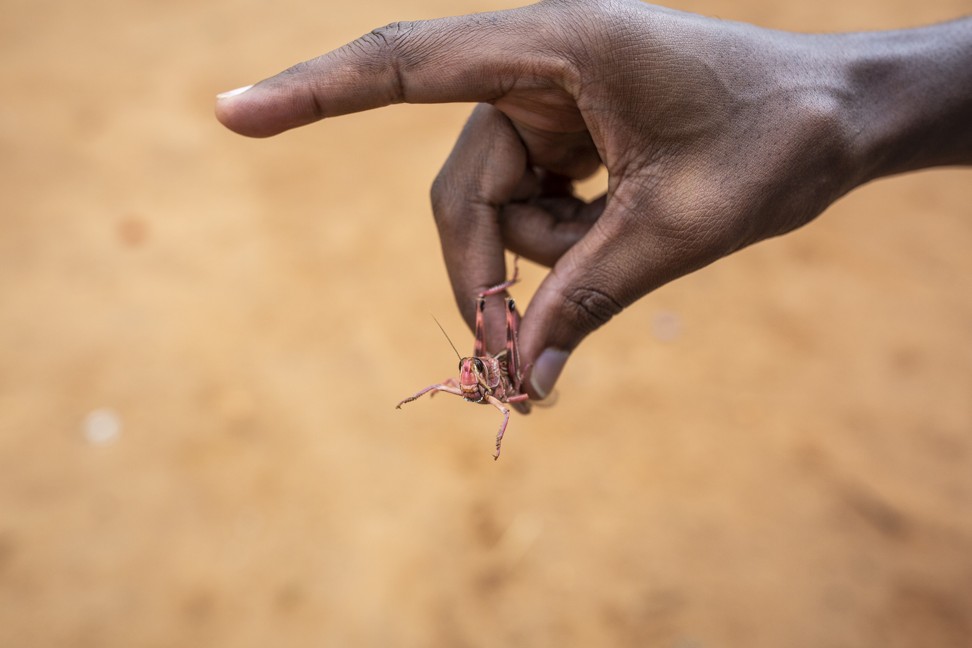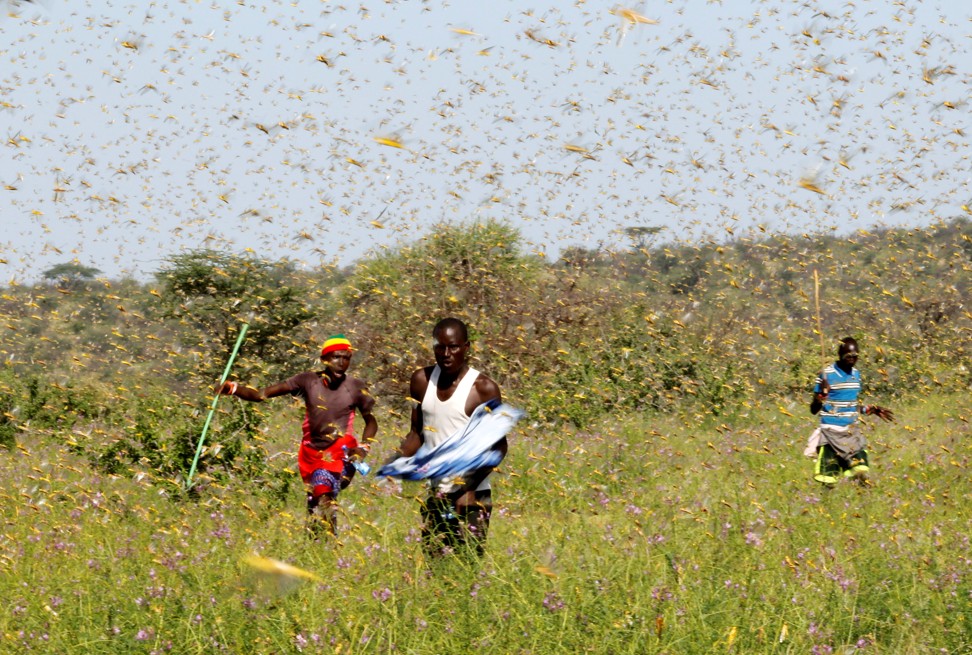Beijing has allocated 1.4 billion yuan (US$200 million) for the prevention and control of pests, including locusts and fall armyworms
UN experts say China unlikely to suffer major infestation because Himalaya mountains act as ‘natural barrier’ for locusts in India and Pakistan
Elaine Chan 22 Feb, 2020

Locusts, which decimate almost all green vegetation including crops and trees, have infested parts of India and Pakistan, bordering China. Photo: Bloomberg
China has heightened prevention and control measures to protect its cropland from desert locusts that have ravaged India and Pakistan, despite assurances that the likelihood of a large-scale attack was marginal.
Locusts, which decimate almost all green vegetation including crops and trees, have swarmed swathes of agricultural land on the India-Pakistan border, an area identified as a global hotspot for the pests by the UN’s Food and Agriculture Organisation (FAO).
The outbreak has raised concerns in neighbouring China, where an economic downturn is already being made worse by the that has killed more than 2,200 people and ground business to a near halt.
However, officials at the FAO have played down the threat, saying a huge plague of locusts was unlikely.

Desert locusts are one of the oldest and most destructive
pests on the planet. Photo: Bloomberg
“There is no threat to China by the desert locust because of a) the wind direction and b) they cannot cross the Himalaya Mountains because they are too tall and the air is too cold – so this is a natural barrier,” said FAO’s senior locust forecasting officer Keith Cressman by email.
China’s Ministry of Agriculture and Rural Affairs agreed the threat was small, but officials are not leaving anything involving national food security to chance.
China’s agriculture sector had a devastating year in 2019, hit by the crop-gobbling fall armyworms, which spread over a million hectares of farmland, as well as African swine fever that has killed about half of the country's 440 million pigs through culling of disease.
Beijing has allocated 1.4 billion yuan (US$200 million) for the prevention and control of pests, including 30 million yuan (US$4.2 million) for locust prevention and control in 15 provinces, according to a Reuters report on Friday.
What’s most important is that the locusts could still make their way inland to Yunnan and Guangxi provinces via Indochina, just like the fall armyworm did, affecting our agriculture
“There is no threat to China by the desert locust because of a) the wind direction and b) they cannot cross the Himalaya Mountains because they are too tall and the air is too cold – so this is a natural barrier,” said FAO’s senior locust forecasting officer Keith Cressman by email.
China’s Ministry of Agriculture and Rural Affairs agreed the threat was small, but officials are not leaving anything involving national food security to chance.
China’s agriculture sector had a devastating year in 2019, hit by the crop-gobbling fall armyworms, which spread over a million hectares of farmland, as well as African swine fever that has killed about half of the country's 440 million pigs through culling of disease.
Beijing has allocated 1.4 billion yuan (US$200 million) for the prevention and control of pests, including 30 million yuan (US$4.2 million) for locust prevention and control in 15 provinces, according to a Reuters report on Friday.
What’s most important is that the locusts could still make their way inland to Yunnan and Guangxi provinces via Indochina, just like the fall armyworm did, affecting our agriculture
Ma Wenfeng
The agriculture ministry said last week it was closely monitoring the locusts’ movements and stepping up prevention efforts, especially in southwest Yunnan province and Tibet, regions close to India and Pakistan, Chinese state media reported.
Agriculture analysts like Ma Wenfeng, of Beijing Orient Agribusiness Consultant, said that while the Himalays acted as a barrier between the mainland and South Asia, any potential threat should not be taken lightly.
“What’s most important is that the locusts could still make their way inland to Yunnan and Guangxi provinces via Indochina, just like the fall armyworm did, affecting our agriculture,” Ma said.
The Chinese government’s prioritisation and preventive measures limited the fall armyworm’s spread and damage to domestic agricultural output, he added.
Pesticide-spraying drones rise to challenge of China’s ‘intelligent agriculture’ ambition
Desert locusts are one of the oldest and most destructive pests on the planet, flying at speeds of 16 to 19km an hour depending on the wind and travelling between 5 to 130km or more in a day, according to the FAO.
A swarm spanning a square kilometre typically contains at least 40 million and sometimes as many as 80 million locusts, with a swarm of about 40 million capable of eating the same amount of food as roughly 35,000 people in a day, the FAO said.
The current infestation of desert locusts appeared around the Red Sea, where two cyclones near the Arabian Peninsula brought heavy rainfall that helped insects breed freely. From there the pests spread through the Horn of Africa and down the continents east coast. The FAO said the infestation in Kenya was the worst in 70 years.

Samburu men attempt to fend-off a swarm of desert locusts
The agriculture ministry said last week it was closely monitoring the locusts’ movements and stepping up prevention efforts, especially in southwest Yunnan province and Tibet, regions close to India and Pakistan, Chinese state media reported.
Agriculture analysts like Ma Wenfeng, of Beijing Orient Agribusiness Consultant, said that while the Himalays acted as a barrier between the mainland and South Asia, any potential threat should not be taken lightly.
“What’s most important is that the locusts could still make their way inland to Yunnan and Guangxi provinces via Indochina, just like the fall armyworm did, affecting our agriculture,” Ma said.
The Chinese government’s prioritisation and preventive measures limited the fall armyworm’s spread and damage to domestic agricultural output, he added.
Pesticide-spraying drones rise to challenge of China’s ‘intelligent agriculture’ ambition
Desert locusts are one of the oldest and most destructive pests on the planet, flying at speeds of 16 to 19km an hour depending on the wind and travelling between 5 to 130km or more in a day, according to the FAO.
A swarm spanning a square kilometre typically contains at least 40 million and sometimes as many as 80 million locusts, with a swarm of about 40 million capable of eating the same amount of food as roughly 35,000 people in a day, the FAO said.
The current infestation of desert locusts appeared around the Red Sea, where two cyclones near the Arabian Peninsula brought heavy rainfall that helped insects breed freely. From there the pests spread through the Horn of Africa and down the continents east coast. The FAO said the infestation in Kenya was the worst in 70 years.

Samburu men attempt to fend-off a swarm of desert locusts
flying over a grazing land in Kenya. Photo: Reuters
Swarms in Pakistan have ravaged crops including wheat and cotton, forcing the country to declare a national emergency on January 31. The pests have crossed over to India and killed crops in the northwest states that border Pakistan.
The FAO has launched a US$76 million appeal to control the situation, but have so far only secured US$20 million, and it is now racing against time as officials warned the swarms are growing at an astonishing pace.
The current challenges were quickly upscaling “survey and control operations to treat all the infestations” and locating the swarms across “large remote areas some of which are insecure”, said Cressman.
This week the Chinese ambassador to Pakistan, Yao Jing, was quoted by local Pakistan media as saying China would consider supplying pesticide and spraying equipment to the country to help it combat the locust attack.
Swarms in Pakistan have ravaged crops including wheat and cotton, forcing the country to declare a national emergency on January 31. The pests have crossed over to India and killed crops in the northwest states that border Pakistan.
The FAO has launched a US$76 million appeal to control the situation, but have so far only secured US$20 million, and it is now racing against time as officials warned the swarms are growing at an astonishing pace.
The current challenges were quickly upscaling “survey and control operations to treat all the infestations” and locating the swarms across “large remote areas some of which are insecure”, said Cressman.
This week the Chinese ambassador to Pakistan, Yao Jing, was quoted by local Pakistan media as saying China would consider supplying pesticide and spraying equipment to the country to help it combat the locust attack.
No comments:
Post a Comment